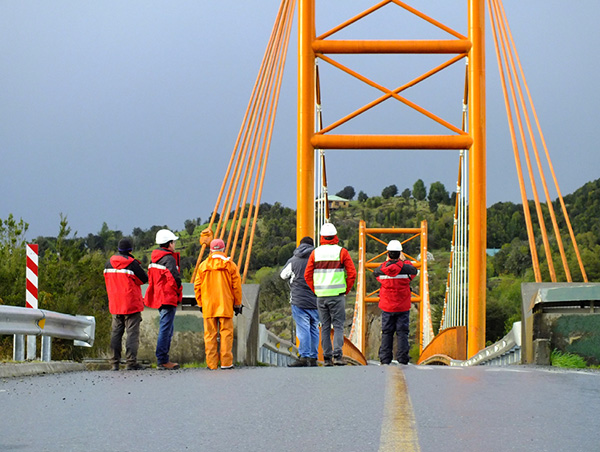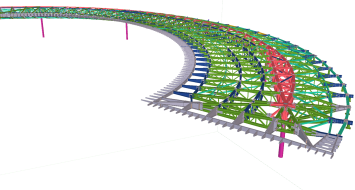
Application methodology of local risk disaster management on Chile (GRDR)
ke syysk. 27 13:44:00 2017
During 2015, the Ministry of Public Works of Chile through the Road Department has proposed a new methodology to management of the prevention and consequences of natural hazards on the infrastructure. The Pontificia Universidad Católica de Valparaíso (PUCV) and Pontificia Universidad Católica de Chile (PUC) are providing the technical support and coordination to this propose.
This proposal method of Chile are based on a Latin-America's study coordinate by COSIPLAN-IIRSA due to the increase various types of natural disasters, including earthquakes, fires, volcanic activity, landslides, mud, among others.
Some natural disaster in the region that have motivated this coordination program are:
• Volcano activity Nevado del Ruiz: November 13, 1985, Department of Tolima, Colombia.
• 2010 Haiti Earthquake (12 January 2010): Epicenter 15 km from Port au Prince, Haiti's Capital, 7.2 magnitude and 316,000 people died.
• Chile Earthquake+ Tsunami 2010: February 27, 2010, Magnitude 8.8, Epicenter in the Chilean Sea, opposite the towns of Curanipe, 264 people died.
• Flood Mexico 2007: October 28 to December 15, 2007, Mexican states of Tabasco and Chiapas, Peak floods of rivers
Chile is high affected by this extreme events not only by earthquake and tsunami, also by heavy rainfall (Atacama 2015 producing infrastructure destruction, deaths and contamination); Volcanic eruption (Los Ríos region 2015, producing destruction of infrastructure and casualties). Even more, the frequency of this extreme event are increasing.
As an example, just two month before to lecture about this topic in Finland, Chile suffered three main extreme events, namely:
• Quellon – Chiloe, on 25 December 2016 Earthquake 7,6 Mw, producing road and bridge collapse and social and economic issues
• Petrohue – Route Ch-225, on 7 January 2017 Rain fall and landslide, producing road collapse and isolation of 100 persons.
• Central zone of Chile about of 800 km, on December 2016 until February, Forest Fires, producing destruction of infrastructure (Santa Olga town) 7154 Casualties, 596.185 HA Native Forrest, burnt, 11 death, information updated on mid of February.
All of these extreme events show the needs of provide a system to protect people and their property, including: institutions, financial mechanism, rules and policies disasters. Even more, the system has to apply in two levels of actions: Pre-Disaster and Post Disaster.
Pre-Disaster includes activities of identification of hazards, mitigation, risk transference and preparation. This last issue is considering in the Chilean methodology proposal as: Early warning system, contingency planning, agents response and shelter/refuge and evacuation.
Post-Disaster includes activities of Emergency Response and reconstruction. Chile in this field has many experience due to the high frequency of traditional extreme event (earthquake), but the change weather are modifying this tendency including an extreme events not frequent as forest fires, landslide among other, that require a review of this post-disaster’s programs.
Finally, an integral system at continental level is proposed and ongoing by COSIPLAN-IIRSA including prevention, mitigation, preparation and reconstruction. This programs are based on determinist and probabilistic assessment.
This condition requires the development of methods for identification of hazards, simulation/modeling of likely scenarios, impacts on society and control measures and mitigation that in South America was named: GRD. The focus of this methodology is the prevention of the consequence mainly in the commerce continental axis, including roads, bridges, tunnels, port, airport, among other.
Unfortunately, many of this assessment has the problem of the management of infrastructure at Central Level (concentrate the knowledge and decisions). In the Chilean case it produce a higher cost of implementation, less knowledge and understanding of the needs of citizens and few knowledge of structures at each sector.
For that reason, in the Chilean methodology (GRDR) includes the decentralization concept, in order to predict the damage of a structure under different types of hazards and prevent future damage, but using a reduce cost of implementation. In this method the manager and inspection risk team at Central Level, transfer knowledge to regional teams, and because of that, they become in the responsible of the Infrastructure management at Regional Level, until certain value of vulnerability of each structures.
In order to provide that transfer, a professional and expert team has to prepare a several inspection sheets and catalog for different structures and potential natural hazards, in order to use it by the local team. This sheets are calibrated by reduce the uncertainties and human errors during the inspection and provide a suitable accuracy result of the damage index and hazard level.
In order to reach that goal, it is propose several local inspections in two levels: Micro-inspection to detected vulnerabilities of the structure and Macro-inspection in order to identify potential natural hazards. This inspections are carry out by local technical groups following a suitable defined inspection sheets and catalogs in order to define a damage index and hazards conditions. This sheets allow to define levels on warning and alerts; in case that the threshold are overpassed, just in that moment, the local group requests the advisory and inspection of an expert team.
During the IABSE Workshop Helsinki 2017: Ignorance, uncertainty and human errors in structural engineering, hold in Tuusula Lake, Finland, this GRDR Method was presented identifying four phases of study, namely: Material damage index, location damage index, hazard assessment and combine hazard assessment.
The first two phases are focus on vulnerability of the structure, using as a baseline the knowledge of damage and pathologies of the maintenance local programs, but modifying the structure and scope of the inspection. The main change of the sheets and proceeding of inspection is the focus of the pathologies associated not only to operative or service condition or strength capacity, but an extreme event's damage is also considered. The material damage are defined including the relative position of this damage on the structural scheme of the structure allowing by expert team provides a damage index.
The RIL and IABSE members discussed about the methodology and the practical experience of this method during the end of 2016, on Patagonia zone, South of Chile. From this start up the inspections sheet was calibrated and it was applied to a specific natural hazard: Volcano activity that produced during 2008 and severe impact in the Chaiten Village. 200 km of road, 2 suspension bridges, 1 cable-stay bridge and 5 traditional bridges was inspected, with a professional and technical team of 8 members. The inspection has provided useful information about the inspections protocols and sheets templates, and also set the requirement for the next start up period on the Valparaiso region in the central zone of Chile, where suffer mainly: earthquake, tsunami, landslide and fires.
Also it provide information to calibrate the sheets and inspection protocols of the first start up carried out in the north of the Chile, Arica and Parinacota Region. In that opportunity an inspection following the first version of the GRDR was applied by a 20 professional team of Peru and Chile, including Poconchile Bridge in a high exposed zone of landslide and the TPA Port of Arica, affected by earthquake and tsunami.
The conclusion of the Workshop about this topic were focus on the current maintenance programs and the way to start an international collaboration. A proposal of collaboration between Finland and Chile are started with the exchange of knowledge in this field and agreements between Universities of both countries (PUCV and Aalto university).
The first activity related is collaboration activity is the possible attend and lecture of Finnish professional and professor (Prof. Dr. Risto Kiviluoma) in the Second International Bridge Congress – Chile 2017 that will be held on Santiago de Chile, on 18 – 20 October 2017 (more info: http://www.acct.cl/?event=conferencia-de-puentes-chile-2017), with the possibility to visit the Patagonia zone where was carried out the GRDR methodology.
The author acknowledges to Ministry of Public Work of Chile and the Pontificia Universidad Católica de Valparaíso for supporting this research and professional activities, with special thanks to P.E Nicolás Valenzuela and Rafael Romo for them contribution. Also thanks to Raul Cuellar and Rolando Tolosa during the inspection
About the author:
Matias has got P.E. Civil Engineering from the University of Chile. He graduated M.Sc. of Structural and Construction Engineering and got Ph.D. in Construction Engineering from Technical University of Catalonia, Barcelona, Spain. Matias is Fiscal Inspector at Ministry of Public Works in Chile and Head of Design and Engineering of the Chacao Multi-Span Suspension bridge. He works actively in international engineering associations including PIARC, IABSE and IABMAS. His research areas include cable-supported bridges, heuristic optimization methods, management of structures, and maintenance of large structures.
Author and photo: Matías A. Valenzuela, P.E, MSc, PhD
Associate Professor by Pontificia Universidad Católica de Valparaíso (PUCV) and Technical Advisor of Ministry of Public Works Chile.
Cover photo: Sergio Sepulveda Bridge - Inspection
Rakennustekniikka on RIL ry:n julkaisema lehti.
Suosituimmat

Suunnitteluprosessin tehostaminen parametrisella suunnittelu...
Parametrinen suunnittelu on osa nykyaikaisen suunnittelutoimiston työkalupakkia.

Inflaatio heiluttaa rakennusalaa, ja esimerkiksi asuntoaloitukset tippuvat vuoden takaises...


